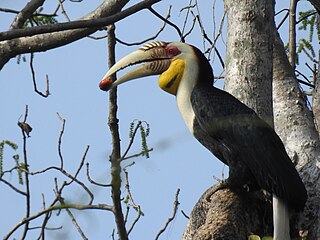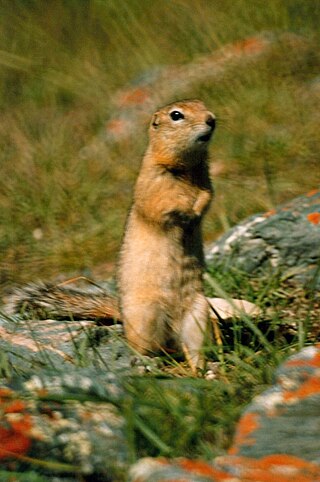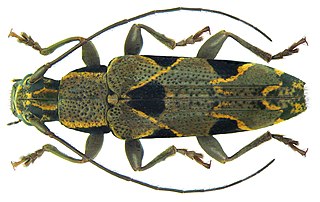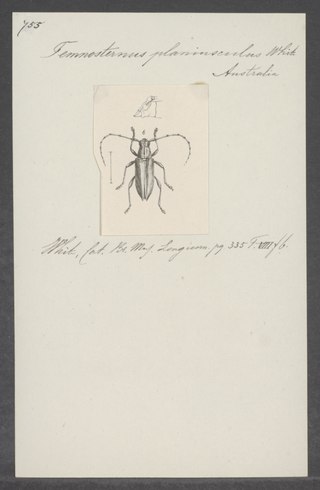
Altocumulus is a middle-altitude cloud genus that belongs mainly to the stratocumuliform physical category, characterized by globular masses or rolls in layers or patches – the individual elements being larger and darker than those of cirrocumulus and smaller than those of stratocumulus. However, if the layers become tufted in appearance due to increased airmass instability, then the altocumulus clouds become more purely cumuliform in structure. Like other cumuliform and stratocumuliform clouds, altocumulus signifies convection. A sheet of partially conjoined altocumulus perlucidus is sometimes found preceding a weakening warm front, where the altostratus is starting to fragment, resulting in patches of altocumulus perlucidus between the areas of altostratus. Altocumulus is also commonly found between the warm and cold fronts in a depression, although this is often hidden by lower clouds.

The budgerigar, also known as the common parakeet, shell parakeet or budgie, is a small, long-tailed, seed-eating parrot. Naturally, the species is green and yellow with black, scalloped markings on the nape, back, and wings. Budgies are bred in captivity with colouring of blues, whites, yellows, greys, and even with small crests. Juveniles and chicks are monomorphic, while adults are told apart by their cere colouring, and their behaviour.

The humphead wrasse is a large species of wrasse mainly found on coral reefs in the Indo-Pacific region. It is also known as the Māori wrasse, Napoleon wrasse, Napoleon fish, so mei 蘇眉 (Cantonese), mameng (Filipino), and merer in the Pohnpeian language of the Caroline Islands.

The eastern fence lizard is a medium-sized species of lizard in the family Phrynosomatidae. The species is found along forest edges, rock piles, and rotting logs or stumps in the eastern United States. It is sometimes referred to as the prairie lizard, fence swift, gray lizard, gravid lizard, northern fence lizard or pine lizard. It is also referred to colloquially as the horn-billed lizard. One of its most notable behaviors is that of its escape behavior when encountering fire ants, which have been known to invade and negatively affect many of their populations.

The wreathed hornbill is an Old World tropical bird of the hornbill family Bucerotidae, also called bar-pouched wreathed hornbill due to its distinctive blue-black band on its lower throat sac. It is named after its characteristic long, curved bill that develops ridges, or wreaths, on the casque of the upper mandible in adults. Males are black with a rufous crown, a white upper breast and face, and a yellow featherless throat. Females are uniformly black with a blue throat and are slightly smaller than males.

The altostratus undulatus is a type of altostratus cloud with signature undulations within it. These undulations may be visible, but frequently they are indiscernible to the naked eye. These formations will generally appear in the early stages of destabilizing return flows, especially over the southern plains of the United States, when the surface temperature is still relatively cool. The wavy strips of clouds are generally near an inversion surface.

The undulated tinamou is a species of ground bird found in a wide range of wooded habitats in eastern and northern South America.

The zigzag heron is a species of heron in the family Ardeidae, also including egrets and bitterns. It is in the monotypic genus Zebrilus. It is found in Bolivia, Brazil, Colombia, Ecuador, French Guiana, Guyana, Peru, Suriname, and Venezuela. Its natural habitat is subtropical or tropical swamps.

The long-tailed ground squirrel or Eversmann's souslik is a species of rodent in the squirrel family Sciuridae. It is found in China, Kazakhstan, Mongolia, and Russia.

Mesodermochelys is an extinct genus of sea turtle known from the Campanian to the Maastrichtian of what today is Japan. One species is known, the type species M. undulatus; it was given its binomial name by Ren Hirayama and Tsutomu Chitoku in 1996. Studies of its skull indicate that it was a primitive member of the Dermochelyidae that was closely related to the Protostegidae. It has been described as the best representative of Mesozoic dermochelyids.

Asperitas is a cloud formation first popularized and proposed as a type of cloud in 2009 by Gavin Pretor-Pinney of the Cloud Appreciation Society. Added to the International Cloud Atlas as a supplementary feature in March 2017, it is the first cloud formation added since cirrus intortus in 1951. The name translates approximately as "roughness".

Holcosus undulatus, also known commonly as the barred whiptail, the metallic ameiva, and the rainbow ameiva, is a species of lizard in the family Teiidae. The species is endemic to Mexico. There are three recognized subspecies.

Tmesisternini is a tribe of beetles in the subfamily Lamiinae containing the following genera:

Temnosternus is a genus of longhorn beetles of the subfamily Lamiinae.

The southwestern fence lizard, also known as Cowles' prairie lizard, the White Sands prairie lizard or the White Sands swift, is species of spiny lizard in the family Iguanidae. The species is native to the Chihuahuan Desert of the south-western United States and north-central Mexico. Originally described in 1956 as Sceloporus undulatus cowlesi, a subspecies of the eastern fence lizard, subsequent DNA studies elevated the southwestern fence lizard to species status.
Temnosternus catulus is a species of beetle in the family Cerambycidae. It was first described by McKeown in 1942. It is known from Australia.
Temnosternus quadrituberculatus is a species of beetle in the family Cerambycidae. It was described by McKeown in 1942. It is known from Australia.
Temnosternus apicalis is a species of beetle in the family Cerambycidae. It was described by Francis Polkinghorne Pascoe in 1878. It is known from Australia.
Temnosternus vitulus is a species of beetle in the family Cerambycidae. It was described by Francis Polkinghorne Pascoe in 1871. It is known from Australia.













